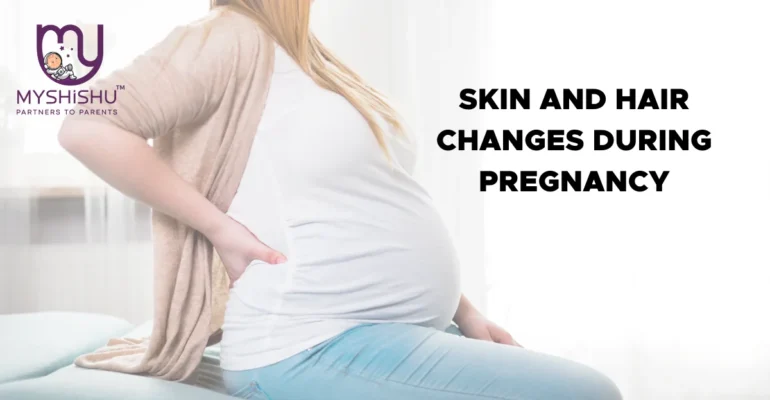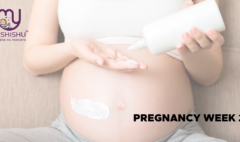Skin And Hair Changes: A Comprehensive Guide
Skin And Hair Changes: A Comprehensive Guide
Skin and Hair changes during pregnancy, a transformative voyage marked by the miracle of life, bring forth an array of changes that extend beyond the visible growth of a baby bump. As we delve into the intricacies of this extraordinary journey, our focus turns to the keywords that define this chapter: skin and hair changes during pregnancy.
Introduction
This is no ordinary metamorphosis. It is a symphony of hormonal shifts, primarily orchestrated by elevated levels of estrogen and progesterone. These changes, often overlooked in the broader narrative of pregnancy, intricately shape the complexion of a pregnant mother’s skin and the texture of her hair.
From the much-celebrated “pregnancy glow” to the subtle emergence of the “mask of pregnancy,” each alteration tells a story of the body’s adaptation to the miracle unfolding within. In this blog post, we embark on a detailed exploration, unraveling the mysteries of stretch marks, celebrating the abundance of enhanced hair, and deciphering the language of the skin—a canvas reflecting the awe-inspiring journey to motherhood.
Join us as we navigate through the nuances of skin and hair changes during pregnancy, understanding the physiological shifts and the profound beauty that accompanies this transformative period.
What are skin and hair changes during pregnancy?
During pregnancy, the body undergoes a series of remarkable changes, and prominent among these are the transformations in the skin and hair. These changes are predominantly driven by hormonal fluctuations, specifically the surge in estrogen and progesterone levels. Referred to as the “pregnancy glow,” increased blood circulation imparts a radiant and healthy complexion, showcasing the body’s response to the growing life within.
However, it’s not just about radiance. Many expectant mothers experience hyperpigmentation, often termed the “mask of pregnancy,” where dark patches appear on the face, particularly on the cheeks, forehead, and upper lip. The skin, stretched to accommodate the developing baby, may develop stretch marks, emphasizing the resilience of the body in this journey.
Hair undergoes its own set of changes, with a surge in hormones stimulating increased growth and alterations in texture. While some women enjoy thicker and more voluminous hair, others may notice changes in curliness or straightness. Understanding these skin and hair changes during pregnancy is about adapting to the physical alterations and embracing the beauty that accompanies this incredible phase of life. In the subsequent sections, we will delve deeper into these changes, offering insights, tips, and guidance for expectant mothers navigating this radiant journey.
Symptoms and Causes of Skin and Hair Changes During Pregnancy
Symptoms:
- The Pregnancy Glow: The famed “pregnancy glow” is a visible manifestation of increased blood circulation and heightened hormone levels. The skin takes on a radiant, flushed appearance, often considered one of the delightful perks of pregnancy.
- Hyperpigmentation: The Mask of Pregnancy Hyperpigmentation, known as the “mask of pregnancy,” presents as dark patches on the face. This phenomenon is attributed to hormonal changes and can affect areas such as the cheeks, forehead, and upper lip. Sun exposure can intensify these pigmentation changes.
- Stretch Marks: As the baby grows, the skin stretches to accommodate the expanding belly. This stretching can lead to the formation of stretch marks, often appearing on the abdomen, breasts, and thighs. While they are a common occurrence, their appearance can be minimized with proper skincare.
- Acne and Skin Sensitivity: Hormonal fluctuations may cause acne breakouts or worsen existing skin conditions. Additionally, some women experience heightened skin sensitivity, requiring adjustments to their skincare routine to prevent irritation.
- Linea Nigra: A vertical dark line, known as linea nigra, may appear on the abdomen. This pigmentation change is temporary and typically fades after delivery.
Causes:
- Hormonal Fluctuations: The primary catalyst for skin and hair changes during pregnancy is the surge in hormones, specifically estrogen and progesterone. These hormones trigger increased blood flow, affecting the skin’s appearance and the hair growth cycle.
- Increased Blood Circulation: The enhanced blood circulation contributes to the “pregnancy glow” by supplying more nutrients and oxygen to the skin. This increased blood flow is a response to the metabolic demands of the developing fetus.
- Genetic Predisposition: Genetic factors play a role in how a woman’s skin responds to hormonal changes. Those with a family history of stretch marks or hyperpigmentation may be more prone to experiencing these changes during pregnancy.
- Sun Exposure: Sun exposure can exacerbate hyperpigmentation, making it essential for pregnant women to use sunscreen with a high SPF and practice sun safety to minimize the risk of dark patches.
- Collagen and Elastic Fiber Changes: The stretching of the skin during pregnancy is influenced by changes in collagen and elastic fibers. These alterations, coupled with hormonal shifts, contribute to the development of stretch marks.
Understanding the symptoms and causes of skin and hair changes during pregnancy provides expectant mothers with valuable insights into the intricacies of this transformative journey. While these changes are natural and often temporary, proper care and a mindful approach can enhance the overall experience and promote skin and hair health during this remarkable period.
Why does it happen?
Skin and hair changes during pregnancy are primarily driven by hormonal fluctuations, notably elevated levels of estrogen and progesterone. These hormones play a pivotal role in orchestrating increased blood circulation, leading to the celebrated “pregnancy glow.” Hyperpigmentation, stretch marks, and alterations in hair texture result from the combined effects of hormonal changes and genetic predispositions. The stretching of the skin is influenced by shifts in collagen and elastic fibers.
Sun exposure can exacerbate pigmentation changes. Understanding these physiological shifts helps expectant mothers navigate and appreciate the natural processes that accompany the extraordinary journey of pregnancy.
Diagnosis and Testing for Skin and Hair Changes During Pregnancy
Diagnosis:
- Clinical Evaluation: The primary diagnosis of skin and hair changes during pregnancy is often made through clinical evaluation. Healthcare professionals, including obstetricians and dermatologists, assess visible symptoms such as hyperpigmentation, stretch marks, and changes in hair texture.
- Medical History: A comprehensive medical history review, including any pre-existing skin conditions or family history of similar changes during pregnancy, aids in understanding individual risk factors and tailoring care.
- Discussion and Observation: Open communication between the expectant mother and the healthcare provider is crucial. Discussing any concerns related to skin and hair changes helps in providing personalized advice and guidance.
Tests:
- Blood Tests: Hormonal levels, particularly estrogen and progesterone, can be assessed through blood tests. This helps in understanding the hormonal fluctuations contributing to skin and hair alterations.
- Genetic Testing: In cases where there’s a family history of certain skin conditions or predispositions, genetic testing may be considered to identify potential risk factors and tailor care accordingly.
- Skin Biopsy (if necessary): In rare instances where skin changes raise concerns, a dermatologist may recommend a skin biopsy. This involves removing a small sample of skin for microscopic examination to rule out any underlying conditions.
- Ultrasonography (for stretch marks): Ultrasonography can be used to assess the depth and severity of stretch marks. While not a routine test, it may be employed in cases where the appearance of stretch marks is a concern.
- Allergy Testing (if applicable): If an expectant mother experiences heightened skin sensitivity or allergic reactions, allergy testing may be recommended to identify specific triggers and guide skincare choices.
Understanding the diagnostic approaches and available tests ensures that healthcare providers can tailor their advice to the specific needs of the expectant mother. While many skin and hair changes during pregnancy are natural and do not require extensive testing, personalized care and attention to individual concerns contribute to a positive pregnancy experience. Always consult with healthcare professionals for accurate diagnosis and guidance.

Management and Treatment of Skin and Hair Changes During Pregnancy
Management Strategies:
- Skincare Routine: Adopt a gentle and hydrating skincare routine. Cleaning with mild, fragrance-free products and moisturizing regularly helps maintain skin health.
- Sun Protection: Due to the increased risk of hyperpigmentation, diligent sun protection is crucial. Use a broad-spectrum sunscreen with a high SPF and wear protective clothing when exposed to sunlight.
- Hydration: Staying well-hydrated supports skin elasticity. Proper hydration can alleviate dryness and contribute to a healthier skin appearance.
- Nutrition: A balanced diet rich in vitamins and minerals is essential. Incorporate foods high in omega-3 fatty acids, antioxidants, and biotin for overall skin and hair health.
- Prenatal Vitamins: Prenatal vitamins prescribed by healthcare providers can supplement nutritional needs, promoting the health of both the mother and the developing baby.
Treatment Approaches:
- Topical Creams and Oils: For stretch marks, applying topical creams or oils containing ingredients like cocoa butter or shea butter can help moisturize the skin and reduce the appearance of stretch marks.
- Safe Acne Treatments: Consult with healthcare professionals for safe acne treatments during pregnancy. They may recommend topical treatments or specific skincare ingredients deemed safe for expectant mothers.
- Hair Care Practices: Adopt gentle hair care practices to minimize breakage. Use a wide-tooth comb, avoid excessive heat styling, and opt for sulfate-free shampoos to maintain a healthy scalp.
- Consultation with a Dermatologist: If skin conditions persist or worsen, seeking advice from a dermatologist is crucial. They can recommend safe and effective treatments tailored to pregnancy.
- Mindful Self-Care: Emotional well-being contributes to physical health. Engage in activities that promote relaxation and reduce stress, as stress can impact skin conditions.
Remember, individual responses to treatments may vary, and it’s essential to consult healthcare professionals before initiating any new regimen. A collaborative approach between expectant mothers and their healthcare providers ensures that management and treatment plans are both effective and safe, nurturing the well-being of both mother and baby during this extraordinary journey.
Preventing Skin and Hair Changes During Pregnancy
- Early Skincare Habits: Initiate a consistent skincare routine early in pregnancy. Use gentle, fragrance-free cleansers and moisturizers to nurture the skin and establish a healthy foundation.
- Sunscreen Protection: Prioritize sun protection to prevent hyperpigmentation. Regularly apply a broad-spectrum sunscreen with a high SPF, especially on exposed areas. Wear protective clothing and seek shade when spending time outdoors.
- Hydration Matters: Maintain optimal hydration levels by drinking ample water. Hydrated skin is more resilient, reducing the likelihood of dryness and contributing to overall skin health.
- Balanced Nutrition: Incorporate a balanced diet rich in vitamins and minerals. Foods high in omega-3 fatty acids, antioxidants, and biotin support skin and hair health.
- Prenatal Vitamins: Begin taking prenatal vitamins as recommended by healthcare providers. These supplements ensure the body receives essential nutrients for both maternal and fetal well-being.
- Mindful Hair Care: Adopt gentle hair care practices early in pregnancy. Use a wide-tooth comb to prevent breakage, minimize heat styling, and opt for sulfate-free shampoos for a healthy scalp.
- Stress Management: Practice stress-reducing activities, such as meditation, yoga, or deep breathing exercises. Chronic stress can impact skin conditions, so fostering emotional well-being is crucial.
- Regular Check-ins with Healthcare Providers: Schedule regular check-ups with obstetricians and dermatologists. Early detection of skin changes allows for proactive management and personalized guidance.
- Allergy Awareness: If prone to allergies or skin sensitivities, be cautious with new skincare products. Allergy testing can identify potential triggers, ensuring a safe and irritation-free routine.
- Weight Management: Strive for gradual and steady weight gain during pregnancy. This can help minimize the severity of stretch marks by allowing the skin to adapt more gradually to the growing belly.
By incorporating these preventive measures into their daily routines, expectant mothers can proactively address potential skin and hair changes. A holistic approach that combines early skincare practices, proper nutrition, and stress management sets the stage for a more comfortable and radiant pregnancy experience. Always consult with healthcare professionals for personalized advice and guidance.
Will this be cured post-birth?
Post-birth, many of the skin and hair changes experienced during pregnancy tend to resolve gradually, although the timeline varies among individuals. Conditions such as stretch marks and linea nigra may fade over time as the skin returns to its pre-pregnancy state. The increased hair volume observed during pregnancy might undergo a shedding phase, a temporary occurrence that often normalizes in the postpartum period. Acne and skin sensitivities may also improve as hormonal levels stabilize.
While some changes may naturally fade, others may persist, requiring ongoing care. Stretch marks, for instance, may not disappear entirely, but their appearance can be minimized with consistent skincare. Consulting with healthcare professionals post-birth allows for tailored guidance on managing any persistent skin or hair concerns. Embracing the changes as part of the miraculous journey of motherhood and maintaining a positive self-image contribute to a smoother postpartum transition.
When to seek the health care provider
Seeking guidance from a healthcare provider during pregnancy is crucial for maintaining both maternal and fetal well-being. However, specific instances related to skin and hair changes warrant prompt attention.
1. Persistent Skin Irritations: If skin irritations, rashes, or allergic reactions persist despite over-the-counter remedies, consulting a healthcare provider ensures a proper diagnosis and tailored treatment plans that are safe for both the mother and the baby.
2. Sudden or Severe Hair Changes: Rapid or severe changes in hair texture, excessive hair loss, or any unusual symptoms warrant a healthcare professional’s evaluation. These changes may signal underlying hormonal imbalances or nutritional deficiencies that require attention.
3. Development of New Moles or Lesions: Any sudden appearance or changes in moles or skin lesions should be promptly examined. While these changes may be benign, monitoring and early detection of potential concerns are essential.
4. Intense Itching or Jaundice: Intense itching, especially on the palms and soles, or the development of jaundice (yellowing of the skin or eyes), could indicate liver-related issues that require immediate medical attention.
5. Emotional Well-Being: Skin and hair changes can impact emotional well-being. If these changes contribute to stress, anxiety, or feelings of self-consciousness, discussing these concerns with healthcare providers ensures holistic support, including potential referrals to mental health professionals.
6. Concerns about Specific Conditions: If there’s a family history of skin conditions, a dermatologist can provide proactive advice and monitoring. Similarly, if there are concerns about genetic predispositions for certain hair conditions, seeking advice early on is beneficial.
Timely communication with healthcare providers ensures a comprehensive approach to maternal care during pregnancy. Whether addressing physical symptoms or supporting emotional well-being, open dialogue fosters a trusting relationship, contributing to a healthier and more positive pregnancy experience.
Additional Common Questions
-
What happens to your hair during pregnancy?
Many women have changes in hair texture and growth during pregnancy. Hormones can make your hair grow faster and fall out less. But these hair changes usually aren’t permanent. Many women lose some hair in the postpartum period or after they stop breastfeeding.
-
Is it normal for your hair to thin during pregnancy?
Telogen effluvium is the excessive shedding of hair that occurs one to five months following pregnancy. Hair loss during pregnancy is not uncommon, as it affects somewhere between 40 to 50% of women; but like most changes during pregnancy, it is temporary.
-
Does your skin change during pregnancy?
Your skin may look healthier during pregnancy, or it may become dry, blotchy, darker, or more sensitive than before you were pregnant. These changes usually go away after your baby is born.
-
Is hair fall common in the first trimester?
Hair loss during pregnancy — while not especially common — is normal, especially when related to hormone changes or certain health conditions. Hair growth should resume with time or with treatment for the underlying cause. Hair shedding after pregnancy peaks around four months postpartum.
-
Why is hair so nice during pregnancy?
“Great hair is something many pregnant women rave about,” says Caroline Ruggiero, a hair specialist and co-owner of Capilia Truly You, a hair-loss treatment clinic in Mississauga, Ont. That’s because during pregnancy you have increased levels of estrogen and androgen, which promote shinier, healthier-looking hair.
Conclusion
In conclusion, the journey of pregnancy encompasses a myriad of skin and hair changes, each telling a unique story of maternal strength and adaptation. While these transformations are a natural part of the miraculous process, seeking guidance from healthcare providers ensures optimal care. Embracing the evolving beauty, both physical and emotional, empowers expectant mothers to navigate this extraordinary chapter with confidence, grace, and the nurturing care they deserve.










